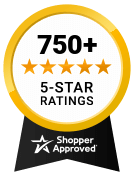Learn More About Heat Seal Laminating
Click the links in the table of contents below to take you to that section of the page:
Table of Contents
- What is the process for heat seal laminating?
- What is the temperature needed to laminate?
- How do I eliminate a hazy or cloudy appearance after laminating?
- How do I eliminate bubbles in the adhesive?
- How do I eliminate curling or waves in the laminated product?
- What safety precautions should I take with the lamination equipment?
- What is the material composition of typical pouches?
- What is a Seamed Pouch?
- What is a Butterfly Pouch?
- What is a Tabbed Butterfly Pouch?
- What size inserts should be used with the pouch?
- What is a Magnetic Stripe?
- What is a Bar Code Mask?
- Place the insert in the pouch
- Place the pouch in a carrier (a standard business envelope or folded paper will suffice); the carrier captures excess adhesive which might be squeezed out during laminating. Without the carrier, excess adhesive will accumulate on the laminator rollers, which will eventually require dismantling the laminator to clean the rollers.
- Feed the carrier through the laminator. Allow the laminator to get to temperature before laminating — see the chart below for the optimum temperature. When in doubt, start with a low temperature and slowly increase the temperature until the pouch adhesive is clear after laminating.
The ideal laminating temperature varies with the laminate thickness:
| Thickness (one side) |
Temp (F) min/max |
| 5 mil thick | 225 / 240 |
| 7 mil thick | 240 / 250 |
| 10 mil thick | 250 / 260 |
After laminating, if the pouch adhesive is still cloudy, the laminating temperature is too low. If the material shows bubbles in the adhesive or a wavy irregular surface, the temperature is too high. In either case, adjust the heat setting and wait a few minutes for the equipment to reach the new temperature.
If the pouch adhesive is still cloudy, process the card through the laminator a second time. The laminator temperature is too low; increase the temperature slowly until the adhesive is clear after processing the card on one pass.
The laminator temperature is too high. Reduce the temperature.
Another possibility is moisture, usually from wet inks — either stamped, written, or photo ID pictures. Wet inks will cause bubbles in the adhesive. Allow the inks to fully dry before laminating.
Using lamination films with less adhesive, also reduces the incidence of bubbles. For example, the typical 10 mil thick film is constructed of 4/6 (film 4 mils thick and adhesive 6 mils thick). However, 10 mil thick material may also be constructed of 2/8 (8 mils adhesive) material or 7/3 (3 mils adhesive) — you will have fewer issues with bubbles by using material with less adhesive.
The laminator temperature is too high. Reduce the temperature.
- To prevent the possibility of electrical shock - DO NOT immerse in water or permit liquid to spill inside the laminator.
- Do not allow articles of clothing (neckties, scarves, etc.) near front or rear of machine. Articles could get caught in openings by rollers and be pulled inside unit causing personal injury.
- Do not insert sharp objects into unit.
- Do not place anything into feed tray opening except laminating material or pouches.
- Do not laminate items, which exceed the total recommended material thickness.
- Do not operate laminator for any purpose other than its intended use.
- Inspect roller cord prior to each use. Do not operate machine if power cord is damaged in any way.
- Turn off power when laminator is not in use.
- Unplug machine when moving.
- Laminators are intended for indoor use only.
- Do not alter or extend electrical plugs.
- Most laminators have a polarized plug. These plugs can fit one way into polarized outlets. If unit does not fit, call a qualified electrician to install a proper outlet.
- Do not change unit plugs.
- Do not overload electrical outlets.
- Prior to moving any parts from unit, call a technician for instructions.
Pouches are made from polyester film and extruded heat seal adhesive. Typically, the amount of polyester film and adhesive is described in a ratio — for example, 10 mil film which is "4/6" is constructed of polyester 4 mils thick and heat seal adhesive which is 6 mils thick. Film which is 5 mils thick might be described as "2/3" which means 2 mils thick polyester and 3 mils thick adhesive.
The front and back sides are joined together by a seamed edge. Typically, the seam is 1/16 inch to 1/8 inch wide, which can affect the size of the insert which will fit into the pouch. This type pouch is provided as a folded pouch with the adhesive sides facing each other.
Since they are constructed from two different films on the front and back sides, seamed pouches can have varying constructions of film materials — different thicknesses, colors, or features (holographic laminates, bar code masks, magnetic stripes, etc).
A butterfly pouch is cut from one piece of lamination film. This type pouch is provided as a flat piece of film, with the adhesive exposed on one side. It must be folded around the insert to make the pouch. It has a scored line where the pouch is intended to be folded. The benefits of a butterfly pouch is that a synthetic film insert can be made to the same size as the pouch, which allows a slightly larger insert and a more professional finished look.
A tabbed butterfly pouch has a small seamed "tab" which is removed and discarded after laminating. This pouch has the same basic construction of the seamed pouch - it is folded with both adhesive sides facing each other. But since the tab is removable and disposable, a synthetic film insert can be made to the same size as the pouch. Tabbed butterfly pouches are usually more expensive than butterfly pouches.
Since they are constructed from two different films on the front and back, Tabbed Butterfly Pouches can have varying constructions of film materials — different thicknesses, colors, or features (holographic laminates, bar code masks, magnetic stripes, etc).
Paper inserts should be slightly smaller than the pouch size. Paper must be encapsulated by a seamed border (minimum 1/8 inch on all sides) for maximum durability. Without the seamed border, the pouch will delaminate if using paper inserts. If there is a punched slot in the pouch, be sure to allow the 1/8 inch border at the slot location too.
Synthetic film inserts (Teslin®, Artisyn®, etc) do not require a seamed border. The insert can be the same size as the pouch. However, if using a "seamed pouch", be sure to make the film insert smaller than the pouch or the insert will extend beyond the laminated edge.
A strip of magnetic tape which can be encoded with variable data. It is usually located on the backside. These are typically used for machine-readable systems like access control. This optional feature is available in high or low coercivity.
To prevent a unique bar code from being copied, an opaque covering is applied inside the pouch at the location of the bar code on the insert. When laminated, this prevents copying of bar codes without affecting machine-readable scans. This optional feature is available in solid black (infrared bar code readers) or red (visible light bar code readers).



